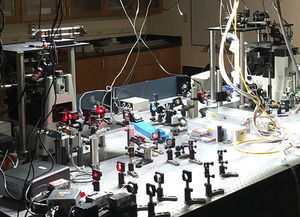Infrared photothermal heterodyne imaging (IR-PHI)
Description

IR-PHI is a super resolution infrared imaging technique based on the infrared absorption-induced photothermal heating of materials. A key distinguishing feature of IR-PHI is its spatial resolution, which is easily an order of magnitude greater than that of traditional Fourier-transform infrared spectroscopy (FTIR) microscopy. Spatial resolution on the order of ~300 nm is possible. This enables single-particle infrared absorption measurements as well as high spatial resolution infrared imaging of materials.
Systems investigated
- individual polystyrene and polymethylmethacrylate beads with diameters between 100 nm and 2 μm
- single E. coli cells
- hybrid perovskite thin films
Publications
- Single semiconductor nanostructure extinction spectroscopy, R. Chatterjee, I. M. Pavlovetc, K. Aleshire, M. Kuno, 2018, J. Phys. Chem. C 2018, 122, 16443-16463. DOI: 10.1021/acs.jpcc.8b00790
- Subdiffraction infrared imaging of mixed cation perovskites: Probing local cation heterogeneities, R. Chatterjee, I. M. Pavlovetc, K. Aleshire, G. V. Hartland, M. Kuno, ACS Energy Lett. 2018, 3, 469-475. DOI: 10.1021/acsenergylett.7b01306
- Super-resolution far-field infrared imaging by photothermal heterodyne imaging: Experiment and theory, Z. Li, K. Aleshire, M. Kuno, G. Hartland, J. Phys. Chem. B 2017, 121, 8838-8846. DOI: 10.1021/acs.jpcb.7b06065
Instrumentation
- tunable IR pump laser between 2.5-3.7 μm (20 kHz) and 5.4-9.6 μm (150 kHz).
- high NA (0.65-0.8) Cassegrain used to focus the IR pump
- high NA (0.9-0.95) refractive objective used to focus a visible wavelength probe beam
- 532 nm, 785 nm or 1060 nm probe wavelengths
- counter propagating pump and probe geometry to take advantage of both high NA objectives
Location
Stepan Hall
Contact
Professor Masaru Kuno mkuno@nd.edu
Professor Greg Hartland hartland.1@nd.edu